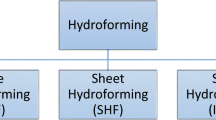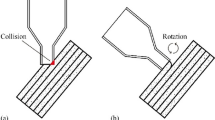Abstract
In wire and arc additive manufacturing (WAAM), it is crucial to maintain a constant travel speed in order to achieve a uniform bead morphology along the tool-path. However, this requirement is always violated in practice because the welding robot has to slow down when sharp corners with high curvatures are encountered so as to satisfy the dynamic constraint. The consequence is excessive fillings (i.e. humps) around these sharp corners, which not only increase the required post processing, but also prevent the continuation of the deposition process if the accumulated errors in the build direction become too large. This issue greatly limits the application of WAAM in the fabrication of complex-shaped components. In this paper, an adaptive process control scheme (APCS) capable of guaranteeing a uniform bead morphology while still respecting the dynamic constraint is proposed. First, the APCS divides the tool-path into several segments depending on whether they contain sharp corners. Then, for each segment, the APCS automatically selects the allowable travel speed subjected to the dynamic constraint, and also the wire-feed rate according to a process model established in advance. Through the matching between the travel speed and the wire-feed rate, a uniform bead morphology among different segments is achieved. Experiments were conducted on a gantry robot using the Cold Metal Transfer (CMT) process, controlled by a self-developed computer numerical control (CNC) system, validating the efficacy of the proposed scheme.
Similar content being viewed by others
References
Gao W, Zhang Y, Ramanujan D, Ramani K, Chen Y, Williams CB, Wang CCL, Shin YC, Zhang S, Zavattieri PD (2015) The status, challenges, and future of additive manufacturing in engineering. Comput Aided Des 69:65–89. https://doi.org/10.1016/j.cad.2015.04.001
Thompson MK, Moroni G, Vaneker T, Fadel G, Campbell RI, Gibson I, Bernard A, Schulz J, Graf P, Ahuja B, Martina F (2016) Design for additive manufacturing: trends, opportunities, considerations, and constraints. CIRP Ann-Manuf Techn 65(2):737–760. https://doi.org/10.1016/j.cirp.2016.05.004
Chen L, He Y, Yang Y, Niu S, Ren H (2017) The research status and development trend of additive manufacturing technology. Int J Adv Manuf Technol 89(9–12):3651–3660. doi: https://doi.org/10.1007/s00170-016-9335-4
Frazier WE (2014) Metal additive manufacturing: a review. J Mater Eng Perform 23(6):1917–1928. https://doi.org/10.1007/s11665-014-0958-z
Bai JY, Fan CL, Lin SB, Yang CL, Dong BL (2016) Effects of thermal cycles on microstructure evolution of 2219-Al during GTA-additive manufacturing. Int J Adv Manuf Technol 87(9–12):2615–2623. https://doi.org/10.1007/s00170-016-8633-1
Ding D, Pan Z, Cuiuri D, Li H (2015) Wire-feed additive manufacturing of metal components: technologies, developments and future interests. Int J Adv Manuf Technol 81(1–4):465–481. https://doi.org/10.1007/s00170-015-7077-3
Li F, Chen S, Shi J, Tian H, Zhao Y (2017) Evaluation and optimization of a hybrid manufacturing process combining wire arc additive manufacturing with milling for the fabrication of stiffened panels. Appl Sci 7(12):1233. doi:https://doi.org/10.3390/app7121233
Urbanic RJ, Hedrick RW, Burford CG (2017) A process planning framework and virtual representation for bead-based additive manufacturing processes. Int J Adv Manuf Technol 90(1–4):361–376. https://doi.org/10.1007/s00170-016-9392-8
Xiong J, Zhang G, Hu J, Wu L (2014) Bead geometry prediction for robotic GMAW-based rapid manufacturing through a neural network and a second-order regression analysis. J Intell Manuf 25(1):157–163. https://doi.org/10.1007/s10845-012-0682-1
Liu X, Ahmad F, Yamazaki K, Mori M (2005) Adaptive interpolation scheme for NURBS curves with the integration of machining dynamics. Int J Mach Tool Manu 45(4):433–444. https://doi.org/10.1016/j.ijmachtools.2004.09.009
Annoni M, Bardine A, Campanelli S, Foglia P, Prete CA (2012) A real-time configurable NURBS interpolator with bounded acceleration, jerk and chord error. Comput Aided Des 44(6):509–521. doi: https://doi.org/10.1016/j.cad.2012.01.009
Bouhal A, Jafari MA, Han WB, Fang T (1999) Tracking control and trajectory planning in layered manufacturing applications. IEEE T Ind Electron 46(2):445–451. https://doi.org/10.1109/41.753784
Thompson B, Yoon H (2014) Efficient path planning algorithm for additive manufacturing systems. IEEE T Comp Pack Man 4(9):1555–1563. https://doi.org/10.1109/TCPMT.2014.2338791
Giberti H, Sbaglia L, Urgo M (2017) A path planning algorithm for industrial processes under velocity constraints with an application to additive manufacturing. J Manuf Syst 43:160–167. doi: https://doi.org/10.1016/j.jmsy.2017.03.003
Jin Y, Du J, Ma Z, Liu A, He Y (2017) An optimization approach for path planning of high-quality and uniform additive manufacturing. Int J Adv Manuf Technol 92(1–4):651–662. https://doi.org/10.1007/s00170-017-0207-3
Tang L, Ruan J, Landers RG, Liou F (2008) Variable powder flow rate control in laser metal deposition processes. J Manuf Sci E 130(4):95–102. https://doi.org/10.1115/1.2953074
Ertay DS, Yuen A, Altintas Y (2017) Synchronized material deposition rate control with path velocity on fused deposition machines. Addit Manuf (in press) 19:205–213. https://doi.org/10.1016/j.addma.2017.05.011
Lin MT, Tsai MS, Yau HT (2007) Development of a dynamics-based NURBS interpolator with real-time look-ahead algorithm. Int J Mach Tool Manu 47(15):2246–2262. https://doi.org/10.1016/j.ijmachtools.2007.06.005
Beudaert X, Lavernhe S, Tournier C (2012) Feedrate interpolation with axis jerk constraints on 5-axis NURBS and G1 tool path. Int J Mach Tool Manu 57(3):73–82. https://doi.org/10.1016/j.ijmachtools.2012.02.005
Liu M, Huang Y, Yin L, Guo JW, Shao XY, Zhang GJ (2014) Development and implementation of a NURBS interpolator with smooth feedrate scheduling for CNC machine tools. Int J Mach Tool Manu 87:1–15. https://doi.org/10.1016/j.ijmachtools.2014.07.002
Huang W, Kovacevic R (2011) A neural network and multiple regression method for the characterization of the depth of weld penetration in laser welding based on acoustic signatures. J Intell Manuf 22(2):131–143. https://doi.org/10.1007/s10845-009-0267-9
Ding D, Pan Z, Cuiuri D, Li H, Duin SV, Larkin N (2016) Bead modelling and implementation of adaptive MAT path in wire and arc additive manufacturing. Robot Cim-Int Manuf 39:32–42. https://doi.org/10.1016/j.rcim.2015.12.004
Almeida PMS, Williams S (2010) Innovative process model of Ti–6Al–4V additive layer manufacturing using cold metal transfer (CMT). Proccedings of the International Solid Freeform Fabrication Symposium:25–36
Adebayo A, Mehnen J, Tonnellier X (2013) Limiting travel speed in additive layer manufacturing. Trends in Welding Research: Proceedings of the 9th International Conference:1038–1044
Funding
This paper was supported by the National Natural Science Foundation of China (no. 51475009) and China Postdoctoral Science Foundation (no. 2017 M610726).
Author information
Authors and Affiliations
Corresponding author
Rights and permissions
About this article
Cite this article
Li, F., Chen, S., Wu, Z. et al. Adaptive process control of wire and arc additive manufacturing for fabricating complex-shaped components. Int J Adv Manuf Technol 96, 871–879 (2018). https://doi.org/10.1007/s00170-018-1590-0
Received:
Accepted:
Published:
Issue Date:
DOI: https://doi.org/10.1007/s00170-018-1590-0




